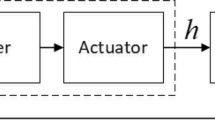Abstract
A free running test using a container ship model clarified properties of effective inflow velocity to propellers in waves. The analysis assumes that thrust and torque vary keeping their relation to the effective inflow velocity as represented by open-water characteristics of a propeller in a steady calm water condition. Measurement in regular waves confirmed the variation of average values of the effective wake coefficient and ship speed depending on wavelength and wave encounter angle. Comparison with the longitudinal flow velocity measured at the sides of the propeller using an onboard vane-wheel current meters confirmed that one can estimate the effective inflow velocity based on thrust or torque data. Theoretical estimates in regular waves based on a strip method are provided and compared with the experimental data. A prediction model of the future inflow velocity is proposed to cope with a time delay of a propeller pitch controller for higher propeller efficiency in waves.












Similar content being viewed by others
References
Taniguchi K (1961) Propulsion performance in waves. Bull Soc Naval Archit Japan 383:315–328 (in Japanese)
McCarthy JH, Norley WH, Ober GL (1961) The performance of a fully submerged propeller in regular waves. David Taylor Model Basin, Report 1440
Nakamura S, Naito S, Inoue R (1975) Open-water characteristics and load fluctuations of propeller in waves. J Kansai Soc Naval Archit Japan 159:41–55 (in Japanese)
Yamanouchi Y, Ando S (1966) Experiments on a Series 60, CB = 0.70 ship model in oblique regular waves. Papers of Ship Research Institute, No. 18
Yoshino T, Saruta T, Yoshino Y (1974) Model tests on thrust and torque increase and fluctuations acting on the propeller shafts of high-speed container ships with single or twin screws in oblique waves. Papers Ship Res Inst 11(4):217–232 (in Japanese)
Sluijs MFV (1972) Performance and propeller load fluctuations of a ship in waves. Netherlands Ship Research Centre TNO, Report No. 163S
Nakamura S, Hosoda R, Naito S (1975) Propulsive performance of a container ship in waves (3rd Report). J Kansai Soc Naval Archit Japan 158:37–46 (in Japanese)
Nakamura S, Hosoda R, Naito S, Inoue M (1975) Propulsive performance of a container ship in waves (4th Report). J Kansai Soc Naval Archit Japan 159:29–39 (in Japanese)
Tsukada Y, Hinatsu M, Hasegawa J (1997) Measurement of unsteady ship wakes in waves. J Kansai Soc Naval Archi Japan 228:15–20 (in Japanese)
Aalbers AB, Gent WV (1985) Unsteady wake velocities due to waves and Motions measured on a ship model in head waves. In: Proceedings of 15th symposium on naval hydrodynamics, vol 15, pp 69–81
Tasaki R (1957) On the characteristics of the driving machine in the self-propulsion test among waves. J Soc Naval Archit Japan 101:25–32 (in Japanese)
Tanizawa K, Ueno M, Taguchi H, Fujiwara T, Miyazaki H, Sawada H, Tsukada Y (2010) The actual model ship basin. Papers Natl Marit Res Inst 10(4):1–40 (in Japanese)
International Ship Structure Congress (1964) Report of the committee 1, Environmental conditions. In: Proceedings of the 2nd ISSC
Hinatsu M, Moriyama F, Tsukada Y, Adachi H (1982) On a correlation between a propeller load and stern flow variation. In: Proceedings of the General Meeting of Ship Research Institute vol 40, pp 86–89 (in Japanese)
Adachi H (1983) On the theoretical bases and application methods of the propeller load varying test method. J Soc Naval Archit Japan 154:109–117 (in Japanese)
Toda Y, Tanaka I, Iwasaki Y (1982) Distortion of axisymmetric boundary layer due to propeller suction. J Kansai Soc Naval Archit Japan 185:39–48 (in Japanese)
Jinnaka T (1958) Some experiments on the exiting forces of waves acting on the fixed ship models. J Soc Naval Archit Japan 103:47–57 (in Japanese)
Jinnaka T (1960) Periodic sources and its applications (continued). J Soc Naval Archit Japan 108:1–4 (in Japanese)
Salvesen N, Tuck EO, Faltinsen M (1970) Ship motions and sea loads. Trans Soc Naval Archit Marine Eng 78:250–287
Hino M (1977) Spectrum analysis. Asakura Shoten (in Japanese)
Tanizawa K, Minami Y (2006) Wave impact avoidance system for ships. Japan Patent JP2008-44472A
Hashimoto N, Nagai N, Shimizu K, Sugawara K (1996) On the Reliability of the statistical wave forecasting through Kalman filtering combined with principal component analysis. Report of the Port and Harbour Research Institute, 35-1, pp 91–115 (in Japanese)
Acknowledgments
The authors thank Mr. Yasushi Kitagawa at the National Maritime Research Institute for his providing the information about a propeller pitch controller of a cargo carrier. This study was supported by the Program for Promoting Fundamental Transport Technology Research from the Japan Railway Construction, Transport and Technology Agency (JRTT).
Author information
Authors and Affiliations
Corresponding author
Appendix
Appendix
Reference test data including ship motion in regular and irregular waves are shown in Figs. 13 and 14.
Time history of pitch angle (bow-up positive), heave acceleration at center of gravity (downward positive), and relative waves at aft perpendicular (upward positive) in irregular waves, corresponding Fig. 5; (χ, wave encounter angle; T 01, primary wave period; H 1/3, designated significant wave height; n, propeller revolution)
About this article
Cite this article
Ueno, M., Tsukada, Y. & Tanizawa, K. Estimation and prediction of effective inflow velocity to propeller in waves. J Mar Sci Technol 18, 339–348 (2013). https://doi.org/10.1007/s00773-013-0211-8
Received:
Accepted:
Published:
Issue Date:
DOI: https://doi.org/10.1007/s00773-013-0211-8





